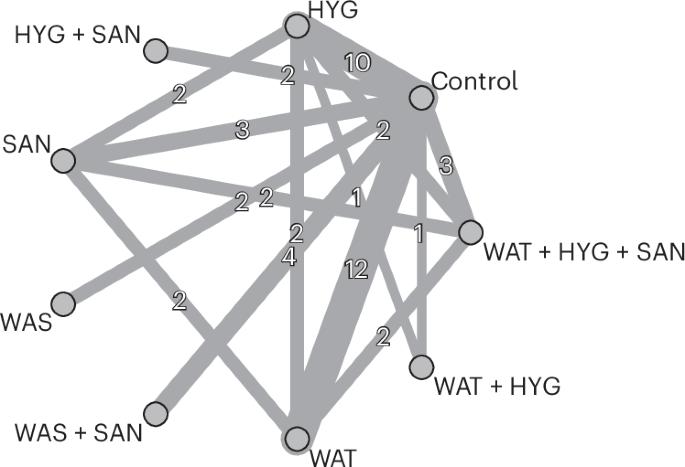Effectiveness of stand-alone and multi-component water, sanitation and hygiene interventions to reduce mortality in childhood: a network meta-analysis
IF 24.1
引用次数: 0
Abstract
Mortality in childhood constitutes the vast majority of the global burden of disease due to diarrhoea and respiratory infection, which is closely related to water, sanitation and hygiene (WASH) use by households. Here we use a component network meta-analysis to evaluate the comparative effectiveness of stand-alone and multi-component WASH interventions in reducing all-cause mortality in childhood in low- and middle-income countries. We find that interventions improving water supplies in quantity and drinking water are associated with reductions in all-cause mortality. Furthermore, we find that, when initial water supplies are improved, hygiene and sanitation interventions are more effective, suggesting that having enough water for washing enables better hygiene and defaecation practices. We also find that WASH packages are less effective than stand-alone interventions and that there are no synergies between interventions. On the contrary, we find some evidence of antagonistic interactions, particularly among interventions with intensive behaviour change components. These findings caution against the implementation of multi-component interventions and also favour prioritizing approaches that improve water supply conditions first. We highlight coordination problems and conflicts between the behavioural changes promoted by the interventions as potential causes of antagonistic interactions. The lack of water, sanitation and hygiene (WASH) infrastructure, especially at the household level, is closely linked to increased child mortality. A meta-analysis that compares the effectiveness of stand-alone versus multi-component WASH interventions cautions against implementing multi-component behavioural interventions and favours prioritizing approaches that improve water supply conditions first.

独立和多组分水、环境卫生和个人卫生干预措施降低儿童死亡率的有效性:网络荟萃分析
儿童死亡率占腹泻和呼吸道感染造成的全球疾病负担的绝大部分,这与家庭用水、环境卫生和个人卫生(讲卫生)密切相关。在这里,我们使用成分网络荟萃分析来评估单独和多成分WASH干预措施在降低低收入和中等收入国家儿童全因死亡率方面的比较有效性。我们发现,改善水供应数量和饮用水的干预措施与全因死亡率的降低有关。此外,我们发现,当最初的供水得到改善时,个人卫生和环境卫生干预措施就会更有效,这表明有足够的洗涤用水可以改善个人卫生和排便习惯。我们还发现,WASH一揽子计划不如单独的干预措施有效,而且干预措施之间没有协同作用。相反,我们发现了一些对抗相互作用的证据,特别是在具有密集行为改变成分的干预措施中。这些发现提醒人们不要实施多成分干预措施,也有利于优先考虑首先改善供水条件的方法。我们强调协调问题和冲突之间的行为变化促进的干预作为对抗相互作用的潜在原因。水、环境卫生和个人卫生基础设施的缺乏,特别是在家庭一级,与儿童死亡率上升密切相关。一项荟萃分析比较了独立与多组分WASH干预措施的有效性,对实施多组分行为干预提出了警告,并倾向于优先考虑首先改善供水条件的方法。
本文章由计算机程序翻译,如有差异,请以英文原文为准。
求助全文
约1分钟内获得全文
求助全文

 求助内容:
求助内容: 应助结果提醒方式:
应助结果提醒方式:


